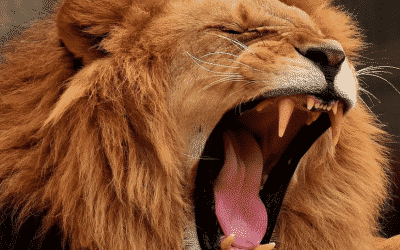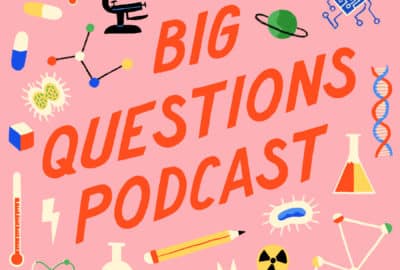What makes the human brain so special?
Wednesday 2nd Nov 2022, 12.30pm
We often hear that we’re remarkably similar to our primate relatives, both in terms of our genetics and our behaviour. We’re social beings. We use tools. But only humans have come to dominate the planet – why? Could the answer lie in the small differences between the human brain and that of other primates? In this episode of the Oxford Sparks Big Questions Podcast, we talk to neuroscientist Dr Rogier Mars about what makes the human brain so special.
Please note that Dr Rogier Mars and his team work on the brains of non-human primates that have died of natural causes, and have subsequently been donated for research purposes.
(Music)
Emily Elias: Monkeys have pretty cool brains, but so do humans. Considering we’re all primates, how do they stack up? It’s time to bust out the MRI and get some answers. On this episode of the Oxford Sparks Big Questions podcast, we’re asking what makes the human brain so special?
(Music)
Hello, I’m Emily Elias, and this is the show where we seek out the brightest minds at the University of Oxford and we ask them the big questions.
And for this one we’re talking to a researcher who has spent years looking at monkey brains.
Rogier Mars: I’m Rogier Mars, I’m a neuroscientist here at the Wellcome Centre, and I look at monkey brains.
Emily: Okay, so you’re looking at monkey brains. Why?
Rogier: Well, I try to compare them to human brains. So the way I look at it is this, we hear a lot in the popular media that we’re like 90% chimpanzee in our genome and that all the behaviours that we thought were unique about a human, like using tools and being very social and taking care of our kids for a long time, that we see those in other places in the animal kingdom.
So more and more people say we’re almost the same, but on the other hand, all the other great apes, for instance, bonobos, chimpanzees, gorillas, orangutans live in small corners of Africa and Asia and are almost extinct, and we dominate this planet for better or for worse.
So how that happens, how that small difference can have that enormous impact, if that’s not an interest scientific question, I don’t know what is.
Emily: Okay, so if you’re looking at monkey brains, I think an obvious question would be, where are you getting your monkey brains from?
Rogier: So, a lot of them we get from zoos around the UK and around Europe. So, a lot of these institutes are really interested in learning more about these animals, so if an animal dies of natural causes, they save a lot of the organs for scientific research, including the brains. So, we get these brains, and we ship them here and we try to look at them.
Emily: So, when you get these brains to Oxford, what do you do with them?
Rogier: The brains are fixed, so they’re preserved in a way that they don’t decay so we can keep them safe for a while. And then we prepare them and put them in an MRI scanner just as you would find in any hospital these days.
Emily: That simple? You’re able to tell how a monkey brain operates, even though it’s not living, through looking at what it does in an MRI?
Rogier: So, the nice thing about MRI is that you can look at many different aspects of how a brain is organised. You can just look at how its grey matter looks like, you can look at its white matter. So, its connections, so how are different areas connected?
You can look at different aspects of the tissues, or what kind of cells do you have at different places. So, you can get all these different kinds of anatomical information even from a brain that’s no longer alive, and all those types of information we can then compare across different species.
Emily: So, when you put it into an MRI, what kind of picture do you get out of it?
Rogier: I’ll show you. Sorry, I’m going to have to log into the server…
Emily: So, this is a brain of a dead animal, yet it looks so alive from the pictures because of how dark in places the colour is, and how light the places in colour is. And it’s very sort of, I would say, like an aurora borealis, almost, sort of like a colour palette, right, where you can see what’s happening.
How are you able to get such a clear image from something that isn’t making active thoughts?
Rogier: It’s pure anatomy. So, in this case what the sequence is sensitive to is the movement of water through the brain. And the movement of water through the brain doesn’t go everywhere unconstrained, it is constrained by the myelin, which is sort of the fatty tissue, the fatty substance around your white matter pathways, and that helps the conduction speed.
So, in certain diseases where that fatty substance is degrading, like multiple sclerosis, the communication between different parts of the brain isn’t very good anymore, but it has the advantage for us that it also doesn’t allow water through.
So if we can just find a way to track the movement of water through the brain, we have a way to reconstruct these tracks.
Emily: So then how do you treat human brains?
Rogier: So, humans, we can thankfully scan when they’re still alive. So yes, we have human volunteers who come in and we use fairly similar protocols – they’re a little bit adapted for living and for non-living brains – but fairly similar protocols to look at the same kind of information so we can compare them. We can compare like with like, which is quite cool.
Emily: So, you have a human brain MRI, you have a monkey brain MRI, what exactly are you looking for in these two different pictures to signal, like, “Hey, this is really special.”
Rogier: So, the thing we mostly look at is the way the brain is wired up. So not every brain area talks to every other part of the brain. There are specific pathways that you can look at, and we can try to compare those across the different species so we can see the way that information is spread across the brain, is that the same across the different species?
And that’s something that MRI is really good at picking up. And thankfully for us, you can also pick that up in a dead brain.
Emily: Is there a specific area of the brain that you’re focussing in on when you’re looking at these two different species?
Rogier: So, if you Google any picture of the brain, what you’ll get is this picture with this large mantle on top which sits on top of the rest of the brain, and that’s what we call the neocortex.
And in the mammalian brain, that is usually the biggest part of the brain, and it’s really, really flexible, really adaptive. It consists of a very regular organisation of cells and it’s very easy for evolution to build more of those. So, you build new areas and it’s very easy to build connections between different parts of that.
So that is the part that we have mostly focussed on, and that is the part that in primate has exploded in terms of size, and some people think also in humans.
Emily: So, what are you able to tell, looking at the neocortex of a human when you compare it against other primates?
Rogier: So, the neocortex is subdivided into different bits. There are bits that we call the primary cortices that gets direct information from the outside, from your eyes, auditory information from your ears, etc., and there are bits that directly talk to the outside world that sends information away to the muscles.
And in-between are what we call association cortex, so these are bits that are not directly connected to the outside world, but are useful in re-processing information, so processing it a bit deeper, combining different sorts of information.
And it’s those parts of the cortex that have really expanded in primates, and particularly in humans. And we want to see how are those wired up, where do they get their information from and do they talk more to one another.
And that seems to be the case in the human brain, that these association parts are much stronger wired together, so they’re able to exchange information much quicker.
Emily: Is that information exchange what makes the human brain so special?
Rogier: For a large part, yes. I think there are a couple of things you could look at if you want to see what makes a brain special, right; you can see does the brain have more neurons? It turns out our brain really does have more neurons than most other species, although maybe not more than you would predict for an ape of our size.
It turns out you can look at the different areas that are there; do we have more areas in the cortex? It turns out, yes we have a couple of areas that you probably don’t find in other apes or monkeys.
And are they wired up differently so they can exchange their information better? And again, that is something that seems to be the case.
So at all these different levels there seems to be something that is a little bit different in our brain.
Emily: So, the human brain is pretty awesome. What about a monkey’s brain, is there anything that’s really special about it that stands out as you’ve compared the two?
Rogier: Well, one thing is we can’t say ‘the monkey brain’, right, and that’s the thing that you learn; every brain is special and adapted to suit the particular behavioural niche of that animal.
So, there are things that the chimpanzee brain would be much better at. There are probably things that certain monkeys would be much better at.
So, every brain has it’s own little specialisations, but we as humans obviously tend to focus most on our own brain. And yes, we still tend to think that we are sort of the pinnacle of evolution, although obviously we are not.
Emily: So obviously you’ve had a vested interest for years looking at different brains of primates and different brains of humans, where are you going next in the animal kingdom, what are you looking for?
Rogier: Well, a couple of things actually. So, we’ve got one project that we’re really invested in at the moment where we are looking at the brains of carnivores.
So, we’re looking at lions and leopards, and cats and dogs, and otters. And the reason is, these animals are all quite clever, like, carnivores are predators, generally, and predators tend to be a little bit cleverer than prey animals. They all have quite big brains, which means that we can image them quite well, but also they’re quite diverse.
So, we’ve got everything that makes it good to study and it’s a fantastic system to try to understand how do differences in brain organisation relate to differences in behaviour.
So that’s one. The other one is we’re looking more and more at rodents because a lot of our medical knowledge is based on knowledge in mice and rats, and we want to know can we help to, by better understanding how brains differ, can we better make that translation between all different things in those animals to help understand the human brain, and even help clinical research.
Emily: You’ve got a lot of time booked on that MRI.
Rogier: We tend to scan in the evenings and the weekends when the scanner is not used for more pressing matters.
Emily: This podcast was brought to you by Oxford Sparks from the University of Oxford, with music by John Lyons and a special thanks to Rogier Mars.
If you liked this podcast, please rate and review us; a few stars goes a long way in podcast land. And check us out on the internet, we’re @oxfordsparks, or we’ve got a website, oxfordsparks.ox.ac.uk.
I’m Emily Elias. Bye for now.
(Music)
Transcribed by UK Transcription.





